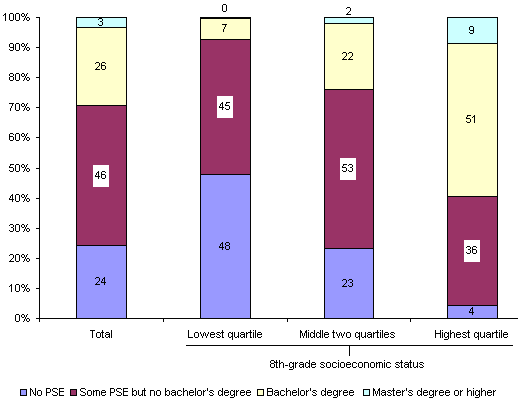Postsecondary Attainment
The fourth follow-up survey of the National Education Longitudinal Study of 1988 (NELS:88) provides data on the educational and labor market outcomes of the eighth-grade cohort of 1988 in the year 2000, when the majority of the cohort was 26 years old.
By 2000, 8 years after most had graduated from high school, 26 percent of the 1988 eighth-grade cohort reported that they had attained a bachelor's degree, and another 3 percent reported earning a master's or higher degree (e.g., a Ph.D. or first-professional degree) (figure 1). Close to one-half of the cohort (46 percent) reported that they had gained some postsecondary credits but had earned either no credential or one below a bachelor's (an associate's degree or certificate). The remaining 24 percent of cohort members had not enrolled in any postsecondary education after high school. Low socioeconomic status students were less likely to have enrolled in postsecondary education and less likely to report that they had attained a bachelor's or higher degree by 2000.
Figure 1.?Percentage distribution of 1988 8th graders according to self-reported educational attainment, by 8th-grade socioeconomic status: 2000

NOTE: Socioeconomic status is based on five equally weighted, standardized components: father's education, mother's education, family income, father's occupation, and mother's occupation. PSE = postsecondary education.
SOURCE: Table 2 in U.S. Department of Education. National Center for Education Statistics. Coming of Age in the 1990s: The Eighth-Grade Class of 1988 12 Years Later, NCES 2002-321. Washington, DC: 2002.